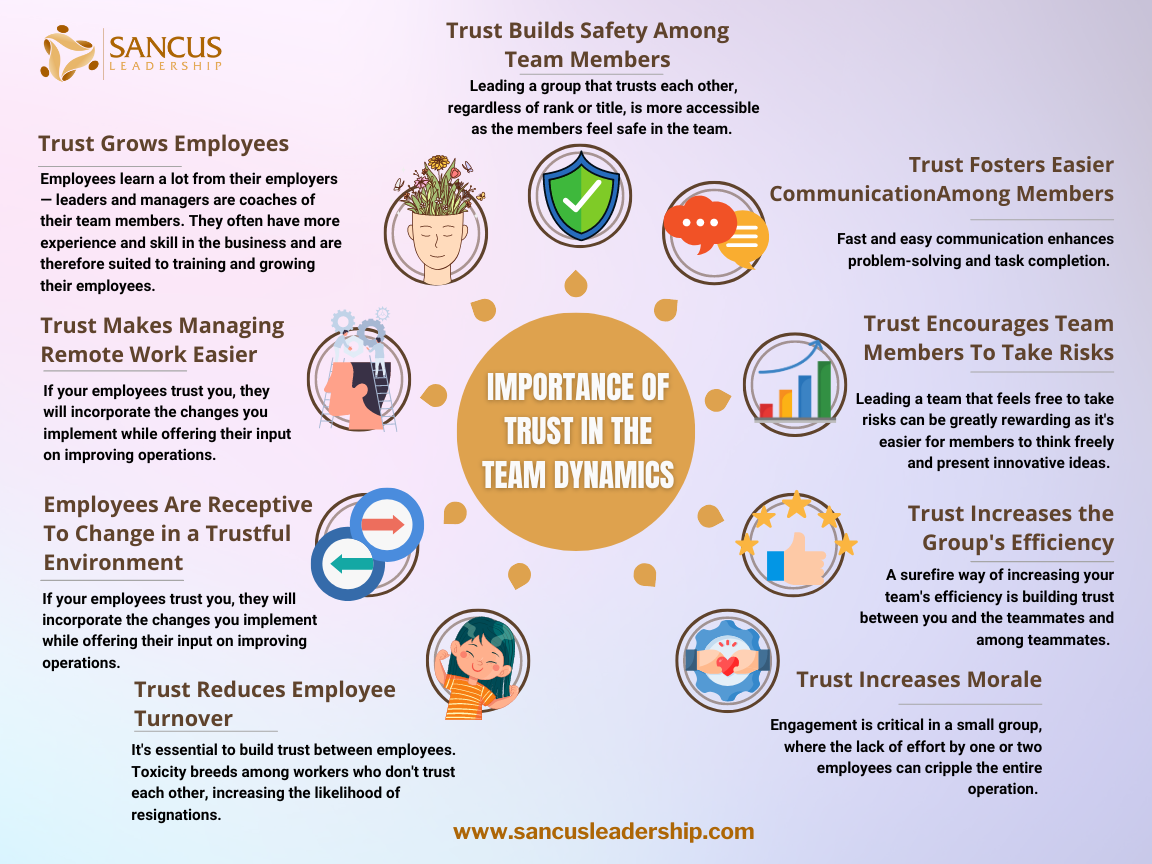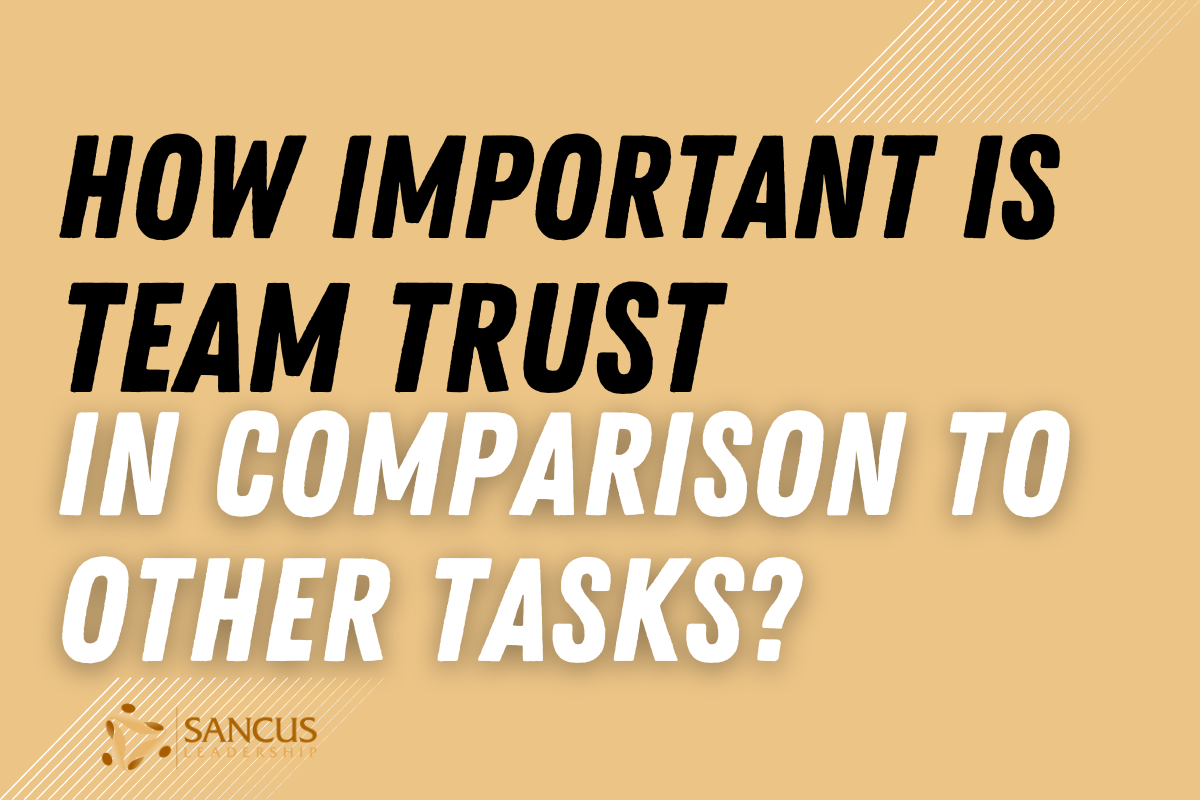As a leader, it’s your responsibility to improve your team’s performance. You can have the best, most qualified software developers in the world in the same company. But trust is necessary for them to perform as individuals, and you’ll miss out on the synergies from a high-trust team.
Building trust with your team is essential because it creates a sense of safety among members, improving productivity, morale, creativity, and risk-taking. Furthermore, faith encourages group members to open up about their weaknesses, allowing you to address them before they affect the team.
This article will look at the importance of trust within a team and allow you to prioritize better trust-building activities about all other tasks you have.
How Important Is Trust in Comparison to Other Team Dynamics?

Trust is the most critical team dynamic – a group cannot function effectively and at its maximum potential without trust. Trust is the glue that holds the team together, improving productivity and creativity.
Through trust, you build a cohesive unit that works to each other’s strengths and is willing to cover for each other’s weaknesses. With faith, it’s nearly possible to improve different team dynamics.
Simon Sinek, in a talk, discusses why trust is the key to high-performing teams and why it is important for leaders to create a trusting environment.
Trust Builds Safety Among Team Members
Trust is a crucial element of military operations, especially EOD (Explosive Ordinance Disposal), where the consequences of making a mistake are significant in every task.
When operating in an environment where the enemy’s primary purpose is to eliminate you, having people you trust watching your back makes you feel safer and perform at a higher level.
Although this is an example from my past on foreign deployments, it also applies to civilian situations since it’s introductory human psychology.
The office environment is much less chaotic and life-threatening than the front lines of a war, but without trust, it can feel like a warzone. When there’s destructive conflict among team members, productivity suffers.
Google surveyed its employees and concluded that psychological safety is the key dynamic in a successful team. Trust creates psychological safety as team members know the group will react positively to inquiries and ideas, fostering an environment where members engage freely.
Conversely, in an untrustworthy setting, individuals will retreat into their shells in fear of the actions and utterings of their teammates. The instinct in a shady work environment is self-preservation and selfishness with ideas.
Leading a group that trusts each other, regardless of rank or title, is more accessible as the members feel safe in the team. Group members produce better results working for a leader they trust. A leader who trusts their team can focus on supporting them and spend more time planning for the future.
Trust Fosters Easier Communication Among Members
Communication is a crucial aspect of success in group settings. Fast and easy communication enhances problem-solving and task completion.
As a leader, you want team members to approach you freely with questions about tasks and projects. They may only come to you with trust between you and your employees. A team member who worries about approaching the leader with an inquiry will much rather muddle through a project than ask for help.
Unsatisfactory results and projects that must be redone are typical signs of teams that fail to communicate. Trust also promotes communication among team members.
Unsatisfactory results and projects that must be redone are typical signs of teams that fail to communicate. Trust also promotes communication among team members.
Most social media posts about unsavory work environments highlight the tones of emails and memos sent among workmates. A simple request from a team member you don’t trust can seem condescending, which might draw a snarky response from you. The lack of trust can lead to a conflict that doesn’t exist.
However, a request or communication from a trustworthy teammate or leader draws positive responses and reactions. The team member knows the person managing them has no ill intentions and only wants the best for the group.
Trust Encourages Team Members To Take Risks
In EOD, risk-taking is a natural part of the job; it is the one skill that every person on the team must be an expert at. Being a risk management expert allows you to explore new avenues of operating, surprise the enemy (your competition), and develop new and better ways of solving problems.
Most leaders punish mistakes harder than they celebrate victory; this is entirely backward if you want to build creativity and trust in your team. People will make mistakes whether or not you punish them, but people will only innovate if you encourage them to do so!
With innovation comes failures (most new ideas fail), but you only need one great idea to pay off all the evil thoughts.
Members will shy away from taking beneficial risks in an untrustworthy environment. For instance, in a workplace where members know they will receive rebuke from the leader if a risk they take fails to pay off, they are unlikely to do so.
People will make mistakes whether or not you punish them, but people will not innovate unless you encourage them to do so!
Conversely, an employee in a team bonded by trust will know they have the support of teammates and their leader when taking reasonable risks.
Leading a team that feels free to take risks can be greatly rewarding as it’s easier for members to think freely and present innovative ideas.
Trust Increases the Group’s Efficiency
A surefire way of increasing your team’s efficiency is building trust between you and the teammates and among teammates. Team sports provide excellent examples of trust’s effect on the unit’s efficiency.
Talented groups with teammates who don’t trust each other often crumble. Conversely, teams with lesser talents bonded by trust regularly exceed expectations.
If we take an American football team as a representation of the team, the coach is the leader, and the players are the team. The coach and the player aim to win games as efficiently as possible.
A team that trusts its coach will carry out the manager’s plays and won’t be afraid to speak out if they disagree with specific calls. That way, the manager and players will determine how to win together. A cohesive manager and team combination is efficient on the pitch and, in your case, in the office.
If the players don’t trust the coach, they are unlikely to perform plays wholeheartedly or offer their input. The same applies in the office – if the team doesn’t trust you, they will disagree with your decisions, leading to poor workplace efficiency, and perhaps more concerningly, they won’t speak out for fear of retribution.
Therefore, the leader and team must function like a well-oiled machine to increase efficiency. The oil that lubricates a high-functioning business team is trust.
Trust Increases Morale
People want to work for leaders they trust. If you want your team to look forward to every day of work, you must build trust.
Team members perpetually psyched up for work produce better results and work better with each other. A manager’s dream is leading a group that enjoys working towards a shared goal.
The term ‘disengagement’ has increased in the quiet quitting era, but it has been around for a long time. Quiet quitting is different from actual quitting in that an employee doesn’t leave the job — they stick around but do the bare minimum due to a lack of morale.
Team members perpetually psyched up for work produce better results and work better with each other.
A study by Jan Pech of Spandrel Group and Bret W. Slade identified two principal reasons for employee disengagement: poor leadership and lack of trust between leaders and subordinates. Employees need more motivation to work if they trust their leaders.
Money is one of the main reasons why people show up for work. However, you want your employees to do more than “show up.” If the employees lack enthusiasm for your tasks, they only do what is required. I mean, why wouldn’t they?
An organization with disengaged employees grows slower than it would with engaged, motivated employees.
Engagement is critical in a small group, where the lack of effort by one or two employees can cripple the entire operation.
Trust Reduces Employee Turnover
As a manager, it’s always frustrating to see an employee leave. The reality of the industry is you’re likely to continue employee turnover. However, you can minimize the rate of employee attrition by building trust between you and your team.
A business that hemorrhages employees will suffer from low productivity and morale. Furthermore, it forces the diversion of funds from other activities into the search for replacements.
This was the case at my old job; when I joined the unit, most of the “old guys” were leaving, and we had a massive drop in competence, which took many years to rebuild.
Instead of having someone say, “We tried that; it didn’t work,” we now had to reinvent the wheel.
The same thing happened when I got out; many of my veteran colleagues exited, leaving the company yet another time without much of its experience.
A study published in October 2019 found that one of the leading causes of employee turnover was the conduct of supervisors, closely followed by limited space for employee growth.
The study posits that your conduct as a leader significantly affects employee retention. Therefore, you must build trust between yourself and your team.
Employees who trust you will see no need to look elsewhere. Employees do not leave their jobs; they leave their bosses.
Employees do not leave their job; they leave their bosses.
Also, employees who trust you know you have their best interests at heart and won’t deny them growth opportunities.
It’s also essential to build trust between employees. Another leading reason why employees leave is toxicity in the workplace. Toxicity breeds among workers who don’t trust each other, increasing the likelihood of resignations.
Employees Are Receptive To Change in a Trustful Environment
Change is inevitable, and so is resistance to change. The effectiveness of alterations in a workplace partially depends on the employees’ adaptation to the changes. Faster adaptation reduces the impact on productivity and workflow.
Change is inevitable, and so is resistance to change.
Transitions in workplaces require cooperation from employees. Employees who don’t trust the employer are more likely to resist change—consequently, the transition time increases, leading to a longer-than-required disruption of company activities.
Managing a small group during a transition is more straightforward than overseeing the changes in a large corporation — fewer people resist change. However, resistance to change, however minimal, can be inconvenient.
If your employees trust you, they will incorporate the changes you implement while offering their input on improving operations.
Many employers appreciated the benefit of building trust with their employees during the 2020 pandemic when circumstances forced workplaces to switch to remote work. Employer and employee combinations bonded by faith adapted quicker to the new working conditions and profited as their less cohesive competitors labored to catch up.
Trust Makes Managing Remote Work Easier
The 2020 pandemic forced the adoption of remote work worldwide. As the pandemic subsided, some employers enforced in-office return policies, others adopted a hybrid system of in-office and remote work, while others went fully remote.
According to a 2022 report by GoodHire, nearly half of the American workforce would accept a pay reduction to continue working remotely. The stat shows that remote work is trendy and here to stay.
Remote work suits a small team of two to ten people – meetings occur online, and workplace operations like file-sharing happen in online workspaces.
Managing employees virtually can be an issue without trust between you and your team. Surveilling your remote workers ceaselessly isn’t feasible, nor is morale, and will distract you from performing more valuable activities.
In a remote environment, you must trust that the employees will meet deadlines and attend meetings as they would in an office. Due to the impracticality and pitfalls of micromanagement, especially in a remote workplace, you must trust that the employees will produce results.
Remote work can benefit your team and business immensely.
Trust Grows Employees
Employee growth improves a company’s productivity: As employee experience grows, competency and productivity increase.
Many employees aim to rise up the ladder, acquiring jobs with better pay and greater responsibility. However, employee development is a possibility. Some work environments hinder employee growth, promoting employee turnover and quiet quitting.
Employees learn a lot from their employers — leaders and managers are coaches of their team members. They often have more experience and skill in the business and are therefore suited to training and growing their employees.
Employees won’t readily take in advice and instruction from leaders they don’t trust. By failing to build trust with your employees, they’re unlikely to see you as a person to improve their skills and competence. Unwilling to abandon their ambitions, they’ll likely look elsewhere.
Additionally, even if you intend to help them grow, employees who don’t trust you will likely be uncooperative and not receptive to your coaching.
| Importance of Trust in Comparison to Other Team Dynamics | Description |
| Trust Builds Safety Among Team Members | When team members trust one another, they feel safe to express their ideas, take calculated risks, and collaborate openly. This trust fosters a sense of psychological safety, where individuals feel comfortable sharing their thoughts and concerns without fear of judgment or reprisal. |
| Trust Fosters Easier Communication Among Members | This open and honest communication leads to improved understanding, collaboration, and problem-solving, ultimately enhancing team cohesion and productivity. Trust acts as a lubricant for smoother interactions, enabling team members to express their ideas and concerns without fear and thus, facilitating a more productive and harmonious work environment. |
| Trust Encourages Team Members To Take Risks | Trust fosters a culture of experimentation, where team members are more willing to push boundaries and explore new opportunities, often leading to growth, innovation, and improved team performance. |
| Trust Increases the Group’s Efficiency | Tasks are completed more swiftly and effectively, contributing to higher productivity and achieving collective goals more efficiently. Trust acts as a catalyst for a team’s overall efficiency and success. |
| Trust Increases Morale | This higher morale leads to increased motivation, engagement, and a willingness to go the extra mile for the team’s success. In such an environment, individuals are more likely to approach challenges with a positive attitude and resilience, ultimately contributing to a happier and more productive work atmosphere. Trust is a cornerstone of high team morale. |
| Trust Reduces Employee Turnover | Trust fosters open communication and problem-solving, addressing issues before they become reasons for employees to leave. Consequently, organizations with a strong foundation of trust tend to retain their talent, reducing the costly and disruptive turnover that can occur when trust is lacking. Trust becomes a critical factor in building a stable and loyal workforce. |
| Employees Are Receptive To Change in a Trustful Environment | Organizations that prioritize trust find it easier to navigate and implement changes effectively, fostering innovation and remaining competitive in a constantly evolving business landscape. Trust is the catalyst for a positive and agile approach to change. |
| Trust Makes Managing Remote Work Easier | Open and transparent communication, fueled by trust, bridges the physical distance, helping teams stay connected and aligned despite being geographically dispersed. In essence, trust is the linchpin for effective and efficient remote work management. |
| Trust Grows Employees | Trust provides a supportive environment where employees feel safe to make mistakes and learn from them, ultimately leading to personal and career advancement. In essence, trust nurtures a culture of continuous improvement and empowers employees to reach their full potential, benefiting both the individual and the organization. Trust is a catalyst for growth and development in the workplace. |

Conclusion
Trust is the first and most crucial dynamic a leader should look to build with his team. Through trust, you create a safe environment that encourages collaboration, feedback, and communication and produces results.
By building trust, the team believes in your leadership and works towards your goals. Faith brings out the best in your team as individuals know they can work freely without fear of unfair rebuke. Crucially, team members who trust their leader openly offer ideas and take risks, which helps grow the operation.



